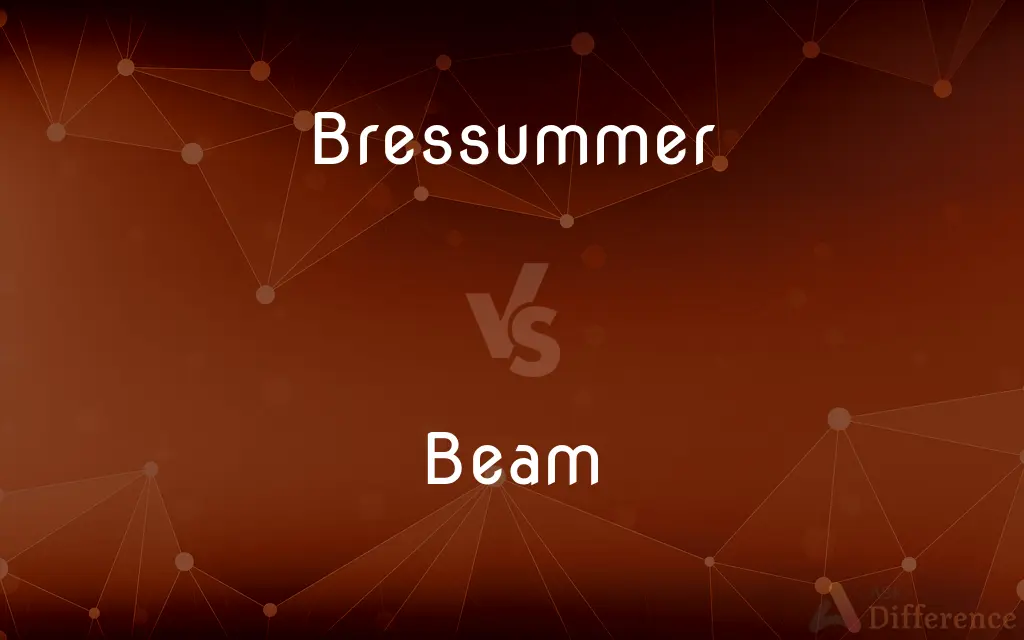Bressummer vs. Beam — What's the Difference?
Edited by Tayyaba Rehman — By Fiza Rafique — Updated on April 8, 2024
Bressummer refers to a specific type of support beam in construction, while a beam is a general structural element used to bear loads.

Difference Between Bressummer and Beam
Table of Contents
ADVERTISEMENT
Key Differences
A bressummer is a specialized beam in architecture and construction, specifically designed to support a significant load, often found above a window or door or at the top of a wall. On the other hand, a beam is a broader term that refers to any long, sturdy piece of wood, metal, or concrete used in construction to support weight, spanning across spaces between supports.
While bressummers serve a specific function, typically bearing the load of a wall or structure above an opening, beams can be utilized in a variety of contexts within a structure, including floors, roofs, and ceilings. This versatility makes beams fundamental components in nearly all building projects.
The term "bressummer" is less commonly used and is specific to certain types of construction or architectural styles, particularly in traditional or timber-framed buildings. In contrast, "beam" is a universally recognized term in construction and engineering, relevant across a wide range of building types and materials.
Bressummers are often exposed in the design of a building, becoming a feature that adds to the aesthetic appeal, especially in historical or traditional architectures. Meanwhile, beams, although sometimes left exposed for aesthetic or architectural reasons, are more often concealed within the structure of a building.
In terms of engineering and construction complexity, installing a bressummer requires specific considerations due to its role in transferring loads from above windows or doors to the foundation. Beams, while also requiring careful planning and installation to ensure they effectively bear and distribute loads, are a more common element with a broader range of applications.
ADVERTISEMENT
Comparison Chart
Definition
A specific type of support beam
A general structural element used to bear loads
Function
Supports loads above openings like windows/doors
Supports structural loads in a variety of contexts
Common Usage
Above windows or doors, in traditional buildings
Floors, roofs, ceilings, across many building types
Terminology
Specific to certain construction styles
Universal in construction and engineering
Aesthetic Impact
Often exposed as a feature in design
Can be exposed or concealed, depending on design
Installation Complexity
Requires specific considerations for load transfer
Requires careful planning for load bearing and distribution
Compare with Definitions
Bressummer
Often exposed as a decorative element.
They chose to highlight the bressummer with a natural finish, accentuating its role and beauty.
Beam
Essential in distributing loads across spaces.
Calculating the load distribution across the beams was a critical step in the design process.
Bressummer
Integral to traditional or timber-framed construction.
The architect specified a solid oak bressummer to preserve the building's historical accuracy.
Beam
A fundamental structural component used in construction to support loads.
The new building's design featured large steel beams for its open-concept spaces.
Bressummer
Requires precise engineering to distribute structural loads.
The structural engineer calculated the load capacity needed for the bressummer to ensure safety.
Beam
Versatile in material, including wood, metal, or concrete.
Wooden beams were chosen for the cabin for their aesthetic warmth and structural capability.
Bressummer
A specific type of beam used to support the load over an opening.
The bressummer above the old cottage's door supported the weight of the thatched roof.
Beam
Sometimes left exposed for architectural appeal.
The loft's design featured exposed beams for an industrial look.
Bressummer
Specific to supporting loads above large openings.
Installing a bressummer was crucial for the wide bay window's structural integrity.
Beam
Can be used in a variety of structural applications.
The renovation plan involved adding beams to support the added second story.
Bressummer
A bressummer, breastsummer, summer beam (somier, sommier, sommer, somer, cross-somer, summer, summier, summer-tree, or dorman, dormant tree) is a load-bearing beam in a timber-framed building. The word summer derived from sumpter or French sommier, "a pack horse", meaning "bearing great burden or weight".
Beam
A long, sturdy piece of squared timber or metal used to support the roof or floor of a building
There are very fine oak beams in the oldest part of the house
The cottage boasts a wealth of exposed beams
Bressummer
(architecture) A large, horizontal supporting beam which bears the weight of a wall starting on a first or higher floor, particularly when exposed or used to support a jetty (timber-frame overhang construction).
Beam
A ray or shaft of light
A beam of light flashed in front of her
The torch beam dimmed perceptibly
Beam
A radiant or good-natured look or smile
A beam of satisfaction
Beam
Transmit (a radio signal or broadcast) in a specified direction
The satellite beamed back radio signals to scientists on Earth
Beam
(of a light or light source) shine brightly
The sun's rays beamed down
Beam
Smile radiantly
She beamed with pleasure
Beam
A squared-off log or a large, oblong piece of timber, metal, or stone used especially as a horizontal support in construction.
Beam
A transverse structural member of a ship's frame, used to support a deck and to brace the sides against stress.
Beam
The breadth of a ship at the widest point.
Beam
The side of a ship
Sighted land off the starboard beam.
Beam
(Informal) The widest part of a person's hips
Broad in the beam.
Beam
A steel tube or wooden roller on which the warp is wound in a loom.
Beam
An oscillating lever connected to an engine piston rod and used to transmit power to the crankshaft.
Beam
The bar of a balance from which weighing pans are suspended.
Beam
(Sports) A balance beam.
Beam
The main horizontal bar on a plow to which the share, coulter, and handles are attached.
Beam
One of the main stems of a deer's antlers.
Beam
A ray or shaft of light.
Beam
A concentrated stream of particles or a similar propagation of waves
A beam of protons.
A beam of light.
Beam
A radio beam.
Beam
To radiate light; shine.
Beam
To smile expansively.
Beam
To emit or transmit
Beam a message via satellite.
Beam
To express by means of a radiant smile
He beamed his approval of the new idea.
Beam
Any large piece of timber or iron long in proportion to its thickness, and prepared for use.
Beam
One of the principal horizontal structural members, usually of steel, timber, or concrete, of a building; one of the transverse members of a ship's frame on which the decks are laid — supported at the sides by knees in wooden ships and by stringers in steel ones.
Beam
(nautical) The maximum width of a vessel (note that a vessel with a beam of 15 foot can also be said to be 15 foot abeam).
This ship has more beam than that one.
Beam
(nautical) The direction across a vessel, perpendicular to fore-and-aft.
Beam
The crossbar of a mechanical balance, from the ends of which the scales are suspended.
Beam
The principal stem of the antler of a deer.
Beam
(literary) The pole of a carriage or chariot.
Beam
(textiles) A cylinder of wood, making part of a loom, on which weavers wind the warp before weaving and the cylinder on which the cloth is rolled, as it is woven.
Beam
The straight part or shank of an anchor.
Beam
The central bar of a plow, to which the handles and colter are secured, and to the end of which are attached the oxen or horses that draw it.
Beam
In steam engines, a heavy iron lever having an oscillating motion on a central axis, one end of which is connected with the piston rod from which it receives motion, and the other with the crank of the wheel shaft.
Beam
A ray or collection of approximately parallel rays emitted from the sun or other luminous body.
A beam of light
A beam of energy
Beam
(figuratively) A ray; a gleam.
A beam of hope, or of comfort
Beam
One of the long feathers in the wing of a hawk.
Beam
(music) A horizontal bar which connects the stems of two or more notes to group them and to indicate metric value.
Beam
(railway) An elevated rectangular dirt pile used to cheaply build an elevated portion of a railway.
Beam
(gymnastics) balance beam
Beam
(ambitransitive) To emit beams of light; to shine; to radiate.
To beam forth light
Beam
To smile broadly or especially cheerfully.
Beam
(transitive) To furnish or supply with beams.
Beam
(transitive) To give the appearance of beams to.
Beam
To transmit matter or information via a high-tech wireless mechanism.
Beam me up, Scotty; there's no intelligent life down here.
The injured crewmembers were immediately beamed to sickbay.
Beam
To transmit, especially by direct wireless means such as infrared.
Beam
To stretch something (for example, an animal hide) on a beam.
Beam
To put (something) on a beam.
Beam
To connect (musical notes) with a beam, or thick line, in music notation.
Beam
Any large piece of timber or iron long in proportion to its thickness, and prepared for use.
Beam
One of the principal horizontal timbers of a building or ship.
The beams of a vessel are strong pieces of timber stretching across from side to side to support the decks.
Beam
The width of a vessel; as, one vessel is said to have more beam than another.
Beam
The bar of a balance, from the ends of which the scales are suspended.
The doubtful beam long nods from side to side.
Beam
The principal stem or horn of a stag or other deer, which bears the antlers, or branches.
Beam
The pole of a carriage.
Beam
A cylinder of wood, making part of a loom, on which weavers wind the warp before weaving; also, the cylinder on which the cloth is rolled, as it is woven; one being called the fore beam, the other the back beam.
Beam
The straight part or shank of an anchor.
Beam
The main part of a plow, to which the handles and colter are secured, and to the end of which are attached the oxen or horses that draw it.
Beam
A heavy iron lever having an oscillating motion on a central axis, one end of which is connected with the piston rod from which it receives motion, and the other with the crank of the wheel shaft; - called also working beam or walking beam.
Beam
A ray or collection of parallel rays emitted from the sun or other luminous body; as, a beam of light, or of heat.
How far that little candle throws his beams!
Beam
A ray; a gleam; as, a beam of comfort.
Mercy with her genial beam.
Beam
One of the long feathers in the wing of a hawk; - called also beam feather.
Beam
To send forth; to emit; - followed ordinarily by forth; as, to beam forth light.
Beam
To emit beams of light.
He beamed, the daystar of the rising age.
Beam
A signal transmitted along a narrow path; guides pilots in darkness or bad weather
Beam
Long thick piece of wood or metal or concrete, etc., used in construction
Beam
A column of light (as from a beacon)
Beam
A group of nearly parallel lines of electromagnetic radiation
Beam
(nautical) breadth amidships
Beam
A gymnastic apparatus used by women gymnasts
Beam
Smile radiantly; express joy through one's facial expression
Beam
Emit light; be bright, as of the sun or a light;
The sun shone bright that day
The fire beamed on their faces
Beam
Express with a beaming face or smile;
He beamed his approval
Beam
Broadcast over the airwaves, as in radio or television;
We cannot air this X-rated song
Beam
Especially of the complexion: show a strong bright color, such as red or pink;
Her face glowed when she came out of the sauna
Beam
Experience a feeling of well-being or happiness, as from good health or an intense emotion;
She was beaming with joy
Her face radiated with happiness
Common Curiosities
Is the installation of a bressummer more complex than a regular beam?
Yes, due to its specific role in load transfer above openings, precise engineering and consideration are required.
Can any beam be used as a bressummer?
Not all beams can serve as bressummers; the beam must be capable of bearing the specific loads encountered above openings.
Can beams be used for purposes other than support?
While their primary function is support, beams can also be utilized for aesthetic purposes in architectural designs.
What distinguishes a bressummer from other beams?
A bressummer is specifically designed to support the load above openings like doors and windows, unlike general beams.
How do engineers decide when to use a bressummer in construction?
Engineers consider the need for a bressummer based on the architectural design, particularly when supporting loads above large openings.
Are bressummers unique to a particular style of architecture?
They are more commonly associated with traditional or timber-framed architecture but can be adapted to various styles.
Why are bressummers often exposed in buildings?
They are exposed for aesthetic reasons, especially in buildings where architectural tradition and design are emphasized.
How does the choice between a bressummer and a beam affect construction costs?
The specific requirements and engineering involved in installing a bressummer can impact costs differently than standard beams.
Can the term 'beam' refer to non-structural decorative elements?
Yes, in architectural design, 'beam' can also refer to decorative elements that mimic the appearance of structural beams.
What materials are commonly used for beams?
Beams can be made from wood, steel, concrete, or other structural materials, depending on the design and load requirements.
Share Your Discovery

Previous Comparison
Overestimate vs. Underestimate
Next Comparison
Shenanigans vs. TomfooleryAuthor Spotlight
Written by
Fiza RafiqueFiza Rafique is a skilled content writer at AskDifference.com, where she meticulously refines and enhances written pieces. Drawing from her vast editorial expertise, Fiza ensures clarity, accuracy, and precision in every article. Passionate about language, she continually seeks to elevate the quality of content for readers worldwide.
Edited by
Tayyaba RehmanTayyaba Rehman is a distinguished writer, currently serving as a primary contributor to askdifference.com. As a researcher in semantics and etymology, Tayyaba's passion for the complexity of languages and their distinctions has found a perfect home on the platform. Tayyaba delves into the intricacies of language, distinguishing between commonly confused words and phrases, thereby providing clarity for readers worldwide.













































